Prepare Your Data For AI
AI
Prepare Your Data For AI
The quality of data fed to AI directly impacts the way it learns, behaves, predicts, and produces results. Simply put, the higher the quality of data, the more precise and reliable the AI’s performance.
With great data comes great responsibility. Or was it power? Either way, nowadays, data is power. Power to make better decisions and solve problems. Power to understand performance and improve processes. And most notably, power to power AI algorithms. Total “power” mentions so far: 7!
Data comes in all shapes and forms and needs to be well-prepped so AI systems, like machine learning, can make the most of it.
If your organization is looking to harness the transformative power (8 mentions, and we’re still a few sentences in!) of data for optimal AI implementation, this article helps you get started.
What data means to AI
Digital transformation across all types of organizations has brought in an abundance of big data. In fact, in 2024 alone 147 zettabytes of data were created and processed. That’s a whopping 7250% increase from 2010.
But here’s the catch: it’s not about having more data; it’s about having the right data for AI to do its job properly.
By analyzing datasets, AI systems learn patterns and trends and build capabilities along the way. When an AI model reads high-quality, accurate data, it works like a charm and generates spot-on results. But what if the data is poor or incomplete? Well, that’s when things can go off the rails, and you end up with erroneous or unreliable outcomes.
So, collecting data is a good start, but the real challenge is shaping that raw data into something AI can actually use. Organizations have been refining their data for years to get better insights into business intelligence, and it’s the same story with AI.
7 steps to make your data AI-ready
Data for AI prep isn’t always easy. There are plenty of challenges, and that’s why a clear, organized approach, like the one below, is essential if you want your AI to really deliver.

- Data collection: Accumulating raw data
The first step in any AI project is gathering raw data from multiple sources. The types of sources you need will depend on the goals of the project. For instance, a retailer aiming to improve customer experience might pull data from point-of-sale systems, customer feedback forms, online reviews, and even social media mentions. - Data preprocessing and profiling: Getting acquainted with your data
With the data collected, the next step is preprocessing. This is where you sift through the data to spot anomalies or missing values that could mess up your results. Maybe some feedback forms lack ratings, or the ratings don’t match the comments, and you need to catch these issues early. - Data cleansing: Fixing the issues
Once you’ve flagged any problems, it’s time to fix them. Data cleansing ensures that everything is reliable and won’t throw off your machine learning models. For example, you might fill in missing ratings with an average score or, in some cases, remove incomplete data entirely. - Data classification: Organizing data based on importance
Not all data is created equal, so you need to organize it based on its sensitivity and relevance. Common categories include Public Data, like product reviews; Internal Data, such as aggregate customer feedback that’s not meant for public eyes; and Confidential Data, which could be personal information or proprietary research that needs strict protection. - Data transformation and feature engineering: Making data useful
Data often needs to be reshaped to fit what machine learning algorithms require. This is where you transform it into the right format. Maybe your sales data is recorded hourly, but you need to look at daily trends. Or perhaps you’re trying to track customer behavior from their first purchase, so you aggregate relevant data accordingly. - Data validation: Quality assurance
After cleansing and transforming the data, you need to double-check everything. Data validation makes sure that your data is consistent and meets the quality standards for your project. This second pass is crucial to catching any remaining issues and ensuring the data is ready for analysis. - Data correlation: Linking data across datasets
To get deeper insights, it helps to find connections between different datasets. Maybe one dataset has timestamps of purchases and amounts spent, while another lists the items bought at those times. By linking these datasets, you can uncover patterns in purchasing behavior that provide valuable insights for your AI application.
Wrapping up
Data is the new oil. It’s valuable in its raw form, but if unrefined, it can’t really be used.
That’s why a well-defined and structured prepping process like the one above is key to data transformation, especially when paired with a dynamic technology like AI.
It’s time to start exploiting your data. You might uncover business gold.

Senior Software Engineer

PREMIUM RESOURCES
FLEXIBLE ENGAGEMENT
Whether you need help with day-to-day operations, professional support in a specific area of technology, a spearhead on a new innovative project, or anything in between, our technology services have you covered for your near and long-term goals. For more information, explore our tech services overview below.




